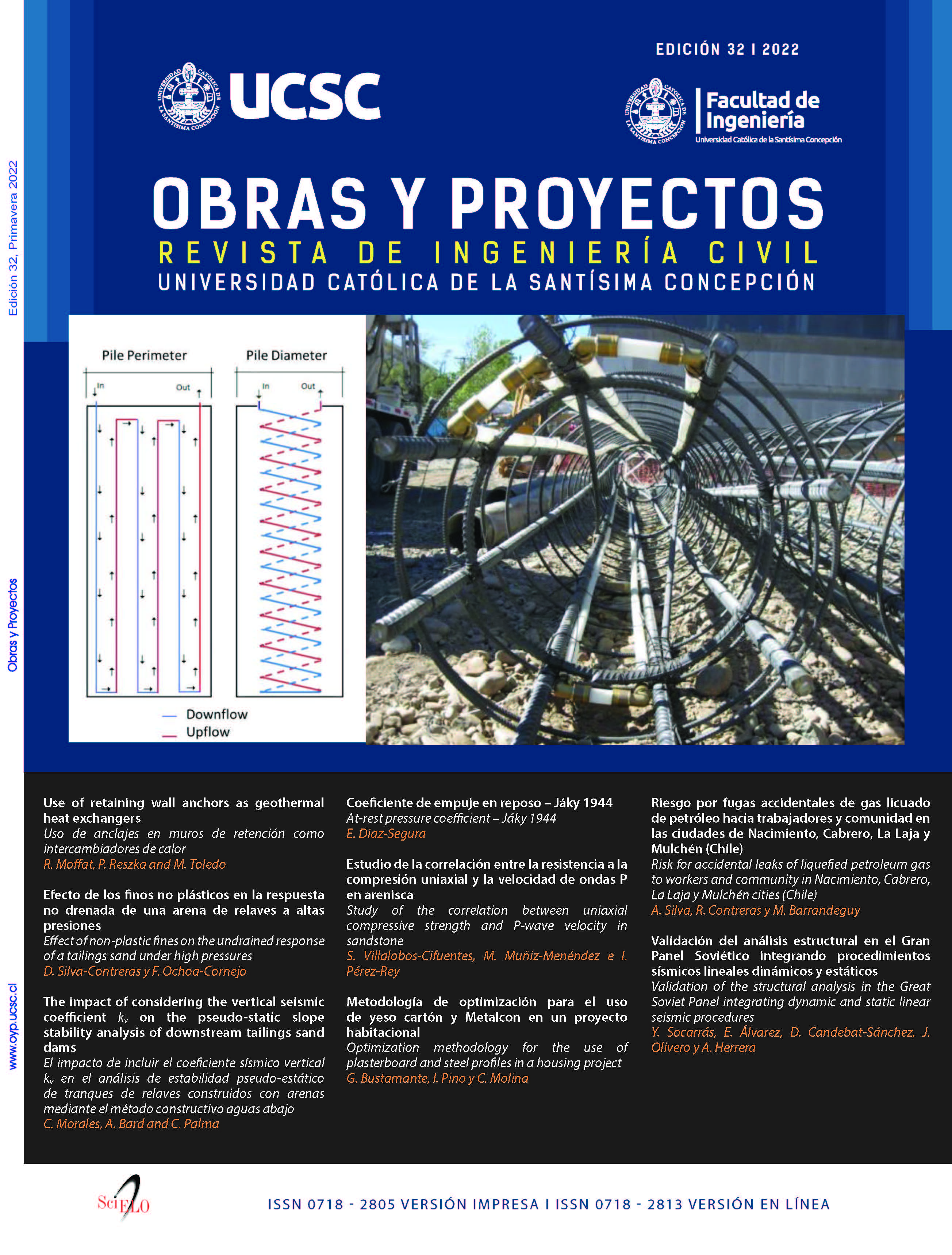Riesgo por fugas accidentales de gas licuado de petróleo hacia trabajadores y comunidad en las ciudades de Nacimiento, Cabrero, La Laja y Mulchén (Chile)
DOI:
https://doi.org/10.21703/0718-51620202203207Palabras clave:
Riesgo laboral, Fuga de gas, Gas licuado de petróleo GLP, Programa Slab ViewResumen
Se evaluaron los riesgos de fugas de GLP, desde estanques de almacenamiento, hacia trabajadores y la comunidad en cuatro ciudades en Chile. La información de los estanques fue obtenida desde fuentes públicas y privadas, complementada con trabajo de campo. Se consideraron estanques de 2 m3 y 4 m3. Se aplicaron las metodologías de análisis de riesgo NTP 937 (2012) y APELL (2015), además del software Slab View para modelar el comportamiento espacial y temporal de las fugas. Como resultado se identificaron 41 estanques de GLP. Del análisis de la aplicación la metodología NTP 937 (2012) se obtuvo que el riesgo por inhalación en 8 de los 9 puestos de trabajo evaluados es de nivel moderado y que el puesto de trabajo con mayor riesgo laboral corresponde al trabajador doméstico con un riesgo moderado y una prioridad de acción clase 2, por lo que se necesita probablemente de medidas correctoras y una evaluación más detallada. De la utilización de la metodología APELL (2015) se obtuvo que en las cuatro ciudades las fugas de GLP tendrían un efecto sobre los trabajadores y la comunidad a un nivel de prioridad clase B y C pudiendo en el último caso ocasionarse heridas graves y serias complicaciones a trabajadores o personas. Finalmente, con Slab View se obtuvo que no existe riesgo por intoxicación debido a que los tiempos de exposición para concentración de 10000 ppm son menores a los 10 min sugeridos por los niveles AEGL (EPA, 2016) y que existen situaciones tiempo-distancia en donde se alcanzan concentraciones de 19000 ppm que podrían ocasionar deflagraciones y una eventual explosión.
Referencias
AFROX (2020). Product reference manual - Liquefied Petroleum Gas. South Africa.
Alfayate, J., González, M., Orozco, C., Pérez, A. y Rodríguez, F. (2004). Contaminación Ambiental: Una visión desde la química. Ediciones Paraninfo S.A. Madrid, España, 19-27.
APELL (2015). Awareness and preparedness for emergencies at local level (APELL). Handbook. Second edition. United Nations Environment Programme UNEP, Geneve, Switzerland.
Carrari, C.L., Aparicio, L.V., Bandoni, J.A. y Tonelli, S.M. (2004). Utilización de modelos de dispersión atmosférica para la estimación de dosis de exposición. Mecánica Computacional 23, 1743-1759.
Cooperativa (2018, 21 de abril). Balance tras explosión en Sanatorio Alemán: Tres muertos y 46 heridos, uno en riesgo vital. https://www.cooperativa.cl/noticias/pais/policial/balance-tras-explosion-en-sanatorio-aleman-tres-muertos-y-46-heridos/2018-04-21/162817.html (18/06/2020).
Emol (2016, 10 de diciembre). Cilindros de gas explotaron en la ruta 68 luego de que el camión que los transportaba volcara a la altura de A. Vespucio. http://www.emol.com/noticias/Nacional/2016/12/10/834931/Camioncargado-con-cilindrosde-gas-volco-en-la-Ruta-68generando-un-incendio.html (18/06/2020).
EPA (2016). Acute exposure guideline levels (AEGLs) – butane and propane. United States Environmental Protection Agency EPA, Washington, USA.
García, J. (1999). Plan de emergencia contra derrames y fugas de productos químicos peligrosos. Mapfre Seguridad 75: 3-13.
Lipigas (2012). Hoja de datos de seguridad de GLP. Empresa Lipigas S.A.
López-Molina, A., Vázquez-Román, R y Díaz-Ovalle, C. (2012). Aprendizajes del accidente de San Juan Ixhuatepec-México. Información Tecnológica 23(6), 121-128.
NTP 937 (2012). Agentes químicos: evaluación cualitativa y simplificada del riesgo por inhalación (III). Método basado en el INRS. Instituto Nacional de Seguridad e Higiene en el Trabajo INSHT, Madrid, España.
Otero, A. (2001). Medio Ambiente y educación: Capacitación en educación ambiental para docentes. Novedades educativas, México.
PNUMA (2017). Acerca de PNUMA/ORPALC. Programa de las Naciones Unidas para el Medio Ambiente PNUMA. http://web.unep.org/es/rolac/acerca-del-pnumaorpalc (18/06/2020).
SLAB View (2015). Emergency release dense gas model. v.5.2. Lakes Environmental, Waterloo, Ontario, Canada. https://www.weblakes.com/software/emergency-release/slab-view/
Descargas
Publicado
Número
Sección
Licencia
Derechos de autor 2022 Universidad Católica de la Santísima Concepción

Esta obra está bajo una licencia internacional Creative Commons Atribución-NoComercial 4.0.








